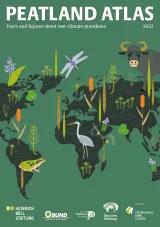
Peatlands and other types of wetlands foster biodiversity and protect humans and nature from drought and flooding. But they are some of the most threatened ecosystems on the planet. Current efforts to conserve them have so far proven inadequate.

The term wetlands includes a range of different ecosystems: marshes, water meadows, peatlands, floodplains, swamps, rivers, lakes, mangroves – and diverse coastal areas. What they all have in common is lots of water. They are sometimes described as the Earth’s kidneys, because they act as natural filters to absorb pesticides and other chemicals and remove nutrients such as nitrate and phosphorus from the water. Covering a total of at least 1.6 billion hectares, wetlands are found all over the world. They have long been under threat: they are disappearing three times faster than forests. Just since 1970, some 35 percent of all wetlands have been destroyed. This has happened either as a result of deliberate drainage, which has increased markedly since the 1960s, or indirectly through falling groundwater levels. Globally, some 350 million hectares of wetlands have already disappeared, of which 50 million hectares used to be wet peatlands. These drained peatlands are the source of at least four percent of worldwide greenhouse gas emissions. The biggest losses of wetlands today are the result of unsustainable forms of agriculture and forestry, the pumping of groundwater, and increasing water pollution. The expansion of industry and infrastructure also contributes to the destruction. In all, one percent of the remaining wetlands are lost each year.
60 percent of humanity lives and works in coastal regions protected by wetlands from flooding. One hectare of wetland can absorb up to 5.6 million litres of floodwater. The continuing destruction of wetlands makes it harder to cope natural disasters, whose numbers have risen tenfold since the 1960s. Floodings, droughts and storms are responsible for up to 90 percent of all the climate-related disasters each year, and the Global South is especially hit hard. People who live in poverty and who have contributed the least to climate crisis are suffering the most.
Some 40 percent of the world's species live and reproduce in wetlands. This biodiversity is at risk: in the past five decades, 81 percent of the plant and animal species in inland wetlands have suffered decline, along with 36 percent of the species in coastal and marine areas. The climate also is hugely affected. Although they cover only 1 percent of the Earth’s surface (including the oceans), wetlands store around one-fifth of global carbon – as long as they remain intact. If they are drained, the stored carbon oxidizes into carbon dioxide (CO₂) and escapes into the atmosphere.
Although the many ecosystem services provided by wetlands have direct links to the Paris Climate Agreement and the 17 global Sustainable Development Goals of the United Nations, there is only a single international agreement that places their protection centre-stage. The Ramsar Convention goes back to 1971, but it is not legally binding. A total of 172 states have acceded to the Convention. These states provide a list of internationally significant wetlands, similar to UNESCO’s list of World Heritage sites. A total of 2,493 sites around the globe, covering a total of 256 million hectares, are currently listed – an area as large as Argentinia. For decades the Ramsar Convention neglected peatlands: they were first brought under the protection of the Convention just 20 years ago. However, because of their importance, these peatlands now account for about one-quarter of the designated wetland areas in the Ramsar registry.
Even if a wetland makes it onto the list, it is not automatically granted protected status. The European Union, however, has various guidelines which can be used to place such areas under special protection. For example, they can be classified as a nature reserve or a flora-fauna habitat.
The United Nations has designated 2021 to 2030 as the Decade on Ecosystem Restoration. In 2019, the United Nations Environment Assembly (UNEA) passed a resolution that focuses on peatlands for the first time, giving new impetus to efforts to protect this land type. All countries of the world expressed their intention to attach greater importance to the sustainable use and restoration of peatlands. The Kunming-Montreal Global Biodiversity Framework of 2022, part of the Convention on Biological Diversity, focuses on the protection of threatened ecosystems such as wetlands and peatlands, and is the largest commitment ever made by the international community for habitat protection. By 2030, at least 30 percent of particularly degraded land and marine areas are to be restored, so these areas can again perform their ecosystem services. In addition, one-third of all land and marine areas are to be placed under protection by 2030. Like the Ramsar Convention, the Montreal-Kunming framework and the UNEA Resolution are not compulsory. But binding agreements are precisely what experts demand: to be able to restore and protect ecosystems, legally enforceable frameworks are vital.

